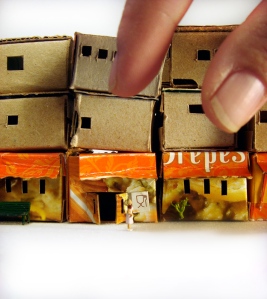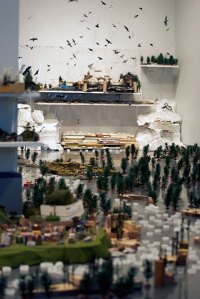Enter Max Liboiron, an artist and academic who creates “walk-in, miniature dioramas” from a city’s discards. Her most recent work, The New York City Trash Exchange, opening September 9th at the AC Institute, represents none other than the great city itself and is, yes indeed, composed of New York City trash.
 |
| Max Liboiron, "The New York City Trash Exchange" (2010) |
Other installations are based on a barter economy. Visitors are free to take away a piece of the installation as long as they replace it with something of equal or greater value in return. The irony of gauging trash’s value is not lost on artist or viewer.
- Liboiron’s work also invokes the archeological, as in Material Afterlife: Circulation where she created 139 lawnscapes and 70 cars then tracked their location as they were taken away by gallery patrons. Liboiron mapped her sculptures’ movement across the continent, like so many migratory birds. For its lowly origins in the city dump, it’s hard not to see the poetry.
 |
| Max Liboiron, "The Dawson City Trash Project" (2008) |
No comments:
Post a Comment